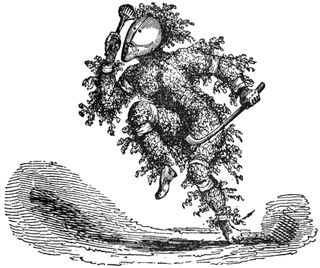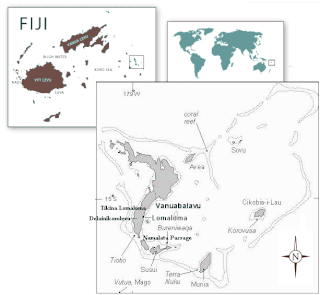Naosara | |
|---|---|
| Issue | Buivaroro Kalouyalewa |
| Father | Lutunasobasoba |
Naosara (pronunciation: NAH-OH-SARAH) was a Fijian High Chief, an ancestor of Fijian royal family.
He was also called Tuʻivanuakula II or Tuʻinaosara. Tu'i means "chief".
Naosara | |
|---|---|
| Issue | Buivaroro Kalouyalewa |
| Father | Lutunasobasoba |
Naosara (pronunciation: NAH-OH-SARAH) was a Fijian High Chief, an ancestor of Fijian royal family.
He was also called Tuʻivanuakula II or Tuʻinaosara. Tu'i means "chief".
Naosara was a son of the High Chief Lutunasobasoba, who is also known as Kubunavanua [1] and was a brother of Degei II. [2] [3] Naosara's mother was High Chiefess Miranalesakula, whose parents are not known.
A brother of Naosara was Chief Daunisai, and he also had a stepmother and at least one sister. [4]

Naosara settled on Nayau, because he was a mighty warrior that fought many battles saving Lau numerous times from being ceded to other neighbouring of the Pacific and they installed him as Lord of Nayau and claiming it as his own and thus he can be assumed to be the first holder of the title Tui Nayau. He married a woman called Gelegeleavanua. Her title was Adi . [5] They eventually had two sons, Buivaroro and Kalouyalewa, who upon reaching adulthood removed themselves to Lakeba. Buivaroro later returned to Nayau and succeeded to his father’s title. Kalouyalewa remained on Lakeba. [6] Naosara also had a daughter, Chiefess Keletu. [7] Grandsons of Naosara were Chiefs Qoma, [8] Delaivugalei, and Tongatapu.

Kubuna is one of the three confederacies that make up Fiji's House of Chiefs, to which all of Fiji's chiefs belong.

ʻEnele Maʻafuʻotuʻitonga, commonly known as Maʻafu, was a Pacific islander who held important titles in two countries in the Pacific. He was a traditional Tongan Prince and a Fijian chief nominated and installed by the Tovata chiefs of Lakeba and Vanua Balavu as 'Tui Lau' in 1869. This title was ratified by a wider council of Fijian chiefs and subsequently formalised under British colonial administration. In 1847, Maʻafu went to Fiji in an expedition to Vanua Balavu to investigate the killing of a preacher.
Tui Nayau is the title held by the paramount chief of the Lau Islands in Fiji and is synonymous with the title holders over lordship of these islands. When translated, Tu’i Nayau means "Lord of Nayau", an island north of Lakeba.
Niumataiwalu was a Fijian high chief. The name Niumataiwalu, translated as "I came first to Walu beach", was in memory of his grandfather Naosara for winning the leadership contest among Rokomautu's seventeen grandchildren at Walu beach, Verata. Niumataiwalu's father, Delaivugalei, was the younger brother of Qoma, whose father was Kalouyalewa.
Rasolo was a Fijian High Chief.
The Lau Islands of Fiji are situated in the southern Pacific Ocean, just east of the Koro Sea. Of this chain of about sixty islands and islets, about thirty are inhabited. The Lau Group covers a land area of 188 square miles, and had a population of 10,683 at the most recent census in 2007. While most of the northern Lau Group are high islands of volcanic origin, those of the south are mostly carbonate low islands.

Lakeba is an island in Fiji’s Southern Lau Archipelago; the provincial capital of Lau is located here. The island is the tenth largest in Fiji, with a land area of nearly 60 square kilometers. It is fertile and well watered, and encircled by a 29-kilometer road. Its closest neighbors are Aiwa and Nayau. Separated by deep sea from the latter but only by shallow waters from the former, when sea levels were lower during glacial episodes Lakeba and Aiwa formed one large island.

Lomaloma is a village at the south of the island of Vanua Balavu in the Lau archipelago of Fiji. The settlement is part of the tribal district of Tikina, Lomaloma and consists of 9 villages, 13 Yavusa (tribes), 42 Mataqali (clans), and 54 family units known as Tokatoka. The nine villages of Lomaloma Tikina are Lomaloma, Sawana, Susui, Narocivo, Namalata, Uruone, Levukana, Dakuilomaloma, and Tuvuca.
Viliame (William) Vuetasau (c.1820-1857) was a Fijian explorer who was the son of Roko Malani, the seventh Roko Sau of Lau and second Tui Nayau and Ciri of Taqalevu. During the reign of his Uncle Taliai Tupou, third Tui Nayau, he was considered heir to the title. He was the first of his noble line to be given a western name, William, after Willam Cary, survivor of the Nantucket whaling ship Oeno that was wrecked in the Lau Islands in 1825. William Cary was rescued by a brother of Malani, who in time became close friends with Malani himself, who named his son after the New Englander, demonstrating his attachment to the shipwrecked sailor.
RokoMalani was high chief of the Fijian island of Lakeba. He held the title Tui Nayau and was a popular chief. He increased the influence the island of Lakeba had in Fiji.
Toki Soroaqali was a Lauan chief and member of the noble dynasty of Vuanirewa in Fiji, active in the late 1700s and early 1800s.
Roko Taliai Tupou (17??-1875) was a Fijian nobleman. He is considered to be the progenitor of the noble household Vatuwaqa in the chiefly Vuanirewa clan and as such, was the first member of this noble household to hold the title Tui Nayau. His reign marked the growth of Christianity in Lau and the slow expansion of Tongan ambitions in Fiji, led by Enele Ma'afu. As this period marked increasing contact with Europeans, records from this point forward in regard to the history of Lau are well documented.

Delailoa was a Fijian High Chief.

Turaga na Rasau is a traditional Fijian chiefly title of the Lau Islands. Prior to Fiji's colonial days, Fiji had many different Vanua with their own Paramount Chieftain which exercised no authority over the other; a saying from the island of Kadavu aptly summarises it "Nomu Turaga o sega na noqu Turaga" or "Your Chief is not my Chief" also the people of Beqa Island were of a similar opinion saying "Qali Cuva Ki Lagi" or "Subject only to heaven" and would bow to no outside Chieftain, but at the turn of the 20th century aspects of the traditional social structure remained, but for administrative purposes three main Matanitu were solidified and formed as they were the dominant consolidated powers at the time being that of Kubuna, Burebasaga and Tovata. With regard to the Rasau while its traditional origins were in Kubuna on Bau the titles traditional authority in modern Fiji is now in Tovata, Lau in particular Lomaloma Tikina on the Island of Vanua Balavu.
Kalouyalewa was a Fijian High Chief.
Buivaroro was a Fijian High Chief and Lord of the island of Nayau.
Maseikula was a Fijian High Chief. He was a Chief of the island of Nayau.

Tu’i Vukinavanua was a Fijian High Chief of the island of Nayau.
In Fiji, Turaga na Roko Tui Bau is a vassal chief of the Vunivalu of Bau. From his seat at the residence of Naicobocobo, the Roko Tui Bau rules the Vusaratu chiefs and has relationships with the Roko Tui Dreketi, Ratu Mai Verata, Roko Tui Namata, Roko Tui Veikau, Tui Vuya and other members of Fiji's House of Chiefs.
Lutunasobasoba is considered to be one of the ancestors of the Fijian (iTaukei) people, along with Degei.